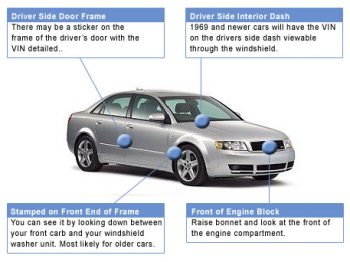What is a VIN or Chassis Number?
What is a VIN or Chassis Number?
The Vehicle Identification Number (VIN) or Chassis Number can be found on the dashboard, driver's side door and on the registration certificate. All cars and light commercial vehicles built after 1981 have a unique 17-character VIN that provides access to valuable information about that vehicle's history.
VIN (Vehicle Identification Number)

VIN is short for Vehicle Identification Number. All vehicles are assigned a VIN when they are manufactured. They are used to uniquely identify all vehicles. Vehicle Identification Numbers are recorded in accidents, insurance records, and when work is done on a vehicle by a body shop, dealership or mechanic. For information on Write-Off's click here.
Vehicles from 1981 to present have 17 character VIN's. Before 1981 may be shorter.
VIN's do not use the letter "I" or "O". These characters are numbers "1" and "0"
1969 and newer vehicles should have VIN on the driver dash.
The first three characters uniquely identify the manufacturer of the vehicle using the world manufacturer identifier or WMI code (World manufacturer identifier).
Section 1: World Manufacturer Identifier (WMI)
A WMI is the first 3 characters of a Vehicle Identification Number which uniquely identifies the manufacturer of a motor vehicle or trailer. The code is assigned to a vehicle manufacturer in order to allow identification of the said manufacturer and when used in conjunction with the remaining section of the VIN, ensures uniqueness of the VIN for all vehicles manufactured for a period of 30 years.
NSAI is the Irish national organisation responsible for issuing manufacturers with a WMI in accordance with International standard ISO 3780. If the manufacturer produces fewer than 500 vehicles in the year the 3rd character of the WMI will be denoted with the number “9” and the 12th, 13th and 14th characters of the VIN will also be assigned by NSAI.
Section 2: Vehicle Descriptor Section (VDS)
It provides information describing the general attributes of the vehicle. This shall consist of 6 characters. If the manufacturer does not use one or more of these character spaces the spaces not used shall be filled by alphabetical or numeric characters of the manufacturer’s choice. The coding and sequence of this section are determined by the manufacturer.
Section 3: Vehicle indicator section (VIS)
This shall be the last section of the Vehicle Identification Number and shall consist of 8 characters; the last four shall be numeric. If the manufacturer chooses to designate year and/or plant in this section; it is recommended that the year be indicated by the first character of the VIS and the plant of manufacture by the second character. Below is the recommended table from which ISO 3779 (1) could be used for assigning the year code for the VIN.
What is the purpose of a VIN number?
A Vehicle Identification Number (VIN) is a unique code used to identify individual motor vehicles, towed vehicles, motorcycles, scooters, and mopeds. The VIN serves multiple purposes:
- Uniqueness and Identification: Every vehicle produced has a unique VIN, making it possible to distinguish one vehicle from another. This is essential for vehicle registration, title, and various legal procedures.
- Theft Prevention and Recovery: If a vehicle is stolen, the VIN can be used to track and identify it. Stolen vehicles often have their VINs altered or removed, but there are typically multiple hidden VIN locations on a vehicle that thieves might not know about.
- Recalls and Service Actions: Manufacturers use VINs to notify vehicle owners of recalls or service actions. If there's an issue with a specific batch of vehicles, the VIN can help pinpoint which ones are affected.
- Vehicle History Reporting: A vehicle's VIN is used to track its history, including sales, accidents, and repairs.
- Insurance: Insurance companies use the VIN to obtain important details about a vehicle, such as make, model, year, and other specifics to calculate premiums and verify claims.
- Production and Registration: Governments and manufacturers use VINs for various administrative tasks, including vehicle registration, titling, and tax collection.
- Decoding Information about the Vehicle: The VIN contains encoded information about the vehicle, such as its manufacturer, where it was built, its type, engine size, model year, and other specifications.
- Ensuring Authenticity: For classic or vintage vehicles, the VIN helps verify the vehicle's authenticity and can be a determining factor in its value.
All of these purposes make the VIN a crucial component in the automotive industry, ensuring vehicle traceability, safety, and transparency for stakeholders ranging from manufacturers to end-users.